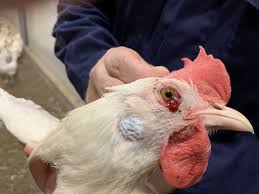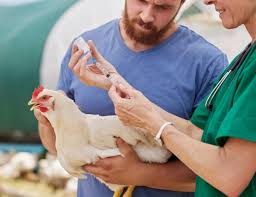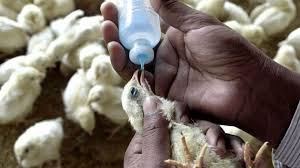A disease is an unhealthy or abnormal physical state or appearance. Diseases in poultry can result from living organisms (infectious agents) or poor environmental conditions caused by improper management. Like humans, non-ruminants are vulnerable to various diseases, including cholera, pox, typhoid, and hepatitis.
Chickens are also susceptible to both internal and external parasites. Some poultry diseases and parasites can be prevented, while others cannot. Certain diseases are fatal, while others may be isolated and controlled. Poultry diseases are categorized as viral, bacterial, fungal, parasitic, or nutritional diseases.
Read Also: How to Process, Package, and Export Papayas (Pawpaw)
Procedure for Disease Identification in Poultry

Detecting signs of disease in poultry is the best method for identifying illnesses in non-ruminants. Some common signs include feather loss (unless birds are molting naturally), general inactivity, discharges, abnormal droppings, dull or closed eyes, ruffled feathers, drooped wings, sitting on haunches, or lying down. The following are key procedures for identifying diseases in poultry or other non-ruminant animals:
1. History Collection: A thorough history often provides essential clues for solving a problem. Collect data on the type of bird, age, feed and water sources, consumption rates, growth, production, morbidity and mortality rates, and any vaccination programs or medications used. Issues may relate to management, environmental conditions, or stress rather than infection. Examine the yard and housing conditions, including ventilation, temperature, litter moisture, and lighting.
2. Examination of Live Birds: Examine the general appearance of individuals or the group to identify the affected organ or system. Look for signs or lesions that may indicate a diagnosis, such as small size with poor feathering, which suggests infectious stunting (malabsorption syndrome).
Check for conditions affecting movement, such as lameness or paralysis, which could point to issues with the nervous system, bones, joints, muscles, or skin. Examine the bird’s skin, listen for abnormal breathing sounds, and check for respiratory distress or infections. Also, examine droppings for signs of diarrhea or other abnormalities.
3. Necropsy: When conducting a postmortem examination, select birds that are representative of the flock’s problem. Sick and dead birds should both be examined. Conduct both external and internal examinations, following a specific routine to ensure no important lesions are missed.
Read Also: The PawPaw/Papaya Ovary: Economic Importance, Uses, and By-Products
Disease Prevention Procedures

Infectious diseases are caused by living microorganisms such as bacteria, viruses, mycoplasma, or parasites. Most infectious diseases are contagious and spread between chickens, although some, like Staphylococcus infections or aspergillosis, are not. Preventing disease involves a combination of sanitation, isolation, vaccination, and medication.
1. Prevention by Sanitation
Sanitation reduces the number of disease-causing organisms that the birds come into contact with, thus preventing disease. The following measures contribute to an effective sanitation program:
i. Cleaning and disinfecting buildings and equipment.
ii. Ensuring adequate ventilation to reduce airborne organisms.
iii. Providing clean feed and water.
iv. Keeping the birds’ environment clean and free from harmful microorganisms.
v. Maintaining good hygiene by caretakers to prevent the spread of infections.
2. Prevention by Isolation
Isolation is a simple disease control method that prevents microorganisms from coming into contact with chickens. Effective isolation depends on understanding where the microorganisms live and how the disease spreads. Isolation practices include:
i. Keeping only one age group on the farm (an all-in, all-out program).
ii. Sourcing chicks or replacements from disease-free and isolated farms.
iii. Isolating the farm from neighboring poultry or free-range chickens.
iv. Cleaning and sanitizing buildings and equipment between flocks.
3. Prevention by Vaccination
Poultry have a strong immune response to many diseases, and vaccination can effectively prevent some of them. Breeding birds require a specialized vaccination program to ensure immunity.
4. Prevention by Medication
Certain diseases, such as coccidiosis and necrotic enteritis, can be prevented by medication. Preventive medication is useful when short-term protection is required, or when natural immunity does not develop. Therapeutic medication can also be used to control the spread of severe infectious diseases.
This article provides an overview of the identification, prevention, and treatment of poultry diseases. It emphasizes the importance of maintaining proper sanitation, isolation, vaccination, and medication practices to prevent diseases in poultry.
These methods are critical in safeguarding poultry health, improving farm productivity, and reducing the impact of disease outbreaks on the farm.
Do you have any questions, suggestions, or contributions? If so, please feel free to use the comment box below to share your thoughts. We also encourage you to kindly share this information with others who might benefit from it. Since we can’t reach everyone at once, we truly appreciate your help in spreading the word. Thank you so much for your support and for sharing!
Read Also: Improve Your Soil: Composting Facts to Create Nutrient-Dense Soil
Frequently Asked Questions
We will update this section soon.

